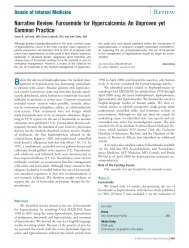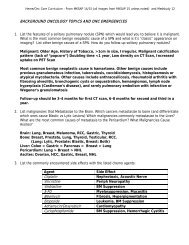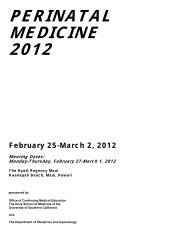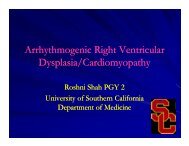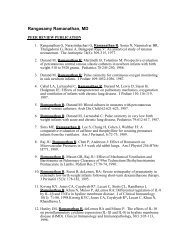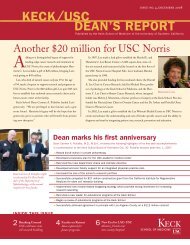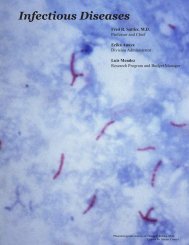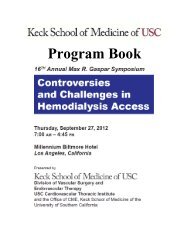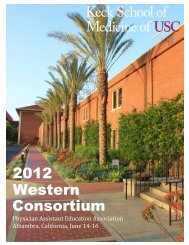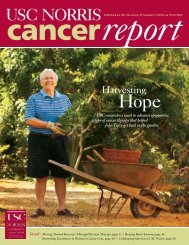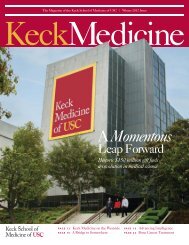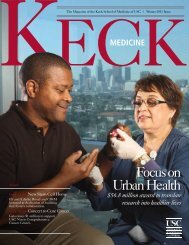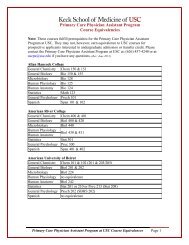Pulmonary and Critical Care Medicine - Keck School of Medicine of ...
Pulmonary and Critical Care Medicine - Keck School of Medicine of ...
Pulmonary and Critical Care Medicine - Keck School of Medicine of ...
You also want an ePaper? Increase the reach of your titles
YUMPU automatically turns print PDFs into web optimized ePapers that Google loves.
In Memory <strong>of</strong>:Henry Gong, Jr., M.D.1947-2007Ricardo H. Juarez, M.D.Kwang-Jin Kim, Ph.D.Janice M. Liebler, M.D.Richard L. Lubman, M.D.Albert H. Niden, M.D.Renli Qiao, M.D., Ph.D.Adupa P. Rao, M.D.Bertr<strong>and</strong> J. Shapiro, M.D.Om P. Sharma, M.D.Hidenobu Shigemitsu, M.D.Graciela J. Soto, M.D.Robert S. Swinney, M.D.Pr<strong>of</strong>essor <strong>of</strong> <strong>Medicine</strong> <strong>and</strong> Preventive <strong>Medicine</strong>Chair, Department <strong>of</strong> <strong>Medicine</strong>, Rancho Los Amigos National Rehabilitation Center (RLANRC)Chief, Environmental Health Service, RLANRCMedical Director, Respiratory <strong>Care</strong> Services, RLANRCAssistant Pr<strong>of</strong>essor <strong>of</strong> Clinical <strong>Medicine</strong>Medical Director, ICU Services, University HospitalMedical Director, <strong>Pulmonary</strong> Exercise CenterMedical Director, High-Altitude Evaluation Test CenterMedical Director, Sleep CenterPr<strong>of</strong>essor <strong>of</strong> <strong>Medicine</strong>Director, Research Seminar SeriesPr<strong>of</strong>essor <strong>of</strong> Clinical <strong>Medicine</strong>Executive Chair, PCCM Alumni ConferenceAssociate Pr<strong>of</strong>essor <strong>of</strong> <strong>Medicine</strong>Pr<strong>of</strong>essor <strong>of</strong> Clinical <strong>Medicine</strong>Associate Chair for County AffairsAssociate Pr<strong>of</strong>essor <strong>of</strong> Clinical <strong>Medicine</strong>Assistant Pr<strong>of</strong>essor <strong>of</strong> Clinical <strong>Medicine</strong>Associate Director, Fellowship Training ProgramMedical Director, Adult Cystic Fibrosis ProgramPr<strong>of</strong>essor <strong>of</strong> Clinical <strong>Medicine</strong>Pr<strong>of</strong>essor <strong>of</strong> <strong>Medicine</strong>Medical Director, Emphysema Management <strong>and</strong> Surgery ProgramMedical Director, Saracoidosis <strong>and</strong> Interstitial Lung Disease CenterAssistant Pr<strong>of</strong>essor <strong>of</strong> Clinical <strong>Medicine</strong>Medical Director, MICU/CMA, LAC+USC Medical CenterMedical Director, Saracoidosis <strong>and</strong> Interstitial Lung Disease CenterAssistant Pr<strong>of</strong>essor <strong>of</strong> Clinical <strong>Medicine</strong>Assistant Pr<strong>of</strong>essor <strong>of</strong> Clinical <strong>Medicine</strong>Director, MICU Data Management System, LAC+USC Medical CenterNEW FACULTYChing-Fei Chang, M.D.Sivagini Ganesh, M.D.Assistant Pr<strong>of</strong>essor <strong>of</strong> Clinical <strong>Medicine</strong>Medical Director, Bronchoscopy Services, LAC+USC Medical CenterAssistant Pr<strong>of</strong>essor <strong>of</strong> Clinical <strong>Medicine</strong>2007-2008 Annual Report167
<strong>Pulmonary</strong> <strong>and</strong> <strong>Critical</strong> <strong>Care</strong> <strong>Medicine</strong>Faculty HonorsMEMBERSHIP IN DISTINGUISHED SOCIETIESZea Borok, M.D.Western Society for Clinical InvestigationEdward D. Cr<strong>and</strong>all, Ph.D., M.D.American Society for Clinical InvestigationWestern Association <strong>of</strong> PhysiciansWestern Society for Clinical InvestigationHenry Gong, Jr., M.D.Western Society for Clinical InvestigationRicardo H. Juarez, M.D.Alpha Omega AlphaJanice M. Liebler, M.D.Western Society for Clinical InvestigationRichard L. Lubman, M.D.Western Society for Clinical InvestigationOm P. Sharma, M.D.Royal College <strong>of</strong> Physicians, London, UKGraciela J. Soto, M.D.Golden Key National Honor SocietyMEMBERSHIP IN PROFESSIONAL SOCIETIESRichard G. Barbers, M.D.American Academy <strong>of</strong> Allergy <strong>and</strong> ImmunologyAmerican College <strong>of</strong> Chest PhysiciansAmerican Thoracic SocietyAsthma <strong>and</strong> Allergy Foundation <strong>of</strong> America, Los Angeles ChapterLos Angeles Academy <strong>of</strong> <strong>Medicine</strong>Los Angeles County Medical SocietyLos Angeles Society <strong>of</strong> Allergy, Asthma <strong>and</strong> Clinical ImmunologyTrudeau Society <strong>of</strong> Los AngelesAhmet Baydur, M.D.American College <strong>of</strong> Chest PhysiciansAmerican College <strong>of</strong> PhysiciansAmerican Thoracic SocietyCalifornia Thoracic SocietySociety <strong>of</strong> <strong>Critical</strong> <strong>Care</strong> <strong>Medicine</strong>Zea Borok, M.D.American College <strong>of</strong> Chest Physicians, FellowAmerican College <strong>of</strong> Physicians, FellowAmerican Federation for Medical ResearchAmerican Society for Cell BiologyAmerican Thoracic SocietySociety <strong>of</strong> <strong>Critical</strong> <strong>Care</strong> <strong>Medicine</strong>C. Thomas Boylen, M.D.American Thoracic SocietyNew York Academy <strong>of</strong> SciencesTrudeau SocietyChing-Fei Chang, M.D.American College <strong>of</strong> Chest PhysiciansEdward D. Cr<strong>and</strong>all, Ph.D., M.D.American Association for the Advancement <strong>of</strong> ScienceAmerican Chemical SocietyAmerican College <strong>of</strong> Chest PhysiciansAmerican College <strong>of</strong> PhysiciansAmerican Federation for Medical ResearchAmerican Heart AssociationAmerican Institute <strong>of</strong> Chemical EngineersAmerican Medical AssociationAmerican Physiological SocietyAmerican Society for Cell BiologyAmerican Thoracic SocietyAssociation <strong>of</strong> Pr<strong>of</strong>essors <strong>of</strong> <strong>Medicine</strong>Biophysical SocietyCalifornia Thoracic SocietyRed Cell ClubSigma XiSociety <strong>of</strong> General PhysiologistsTau Beta PiTrudeau SocietyPatricio Escalante, M.D.American Academy <strong>of</strong> Sleep <strong>Medicine</strong>American College <strong>of</strong> Chest PhysiciansAmerican Thoracic SocietyCalifornia Thoracic SocietySociety <strong>of</strong> <strong>Critical</strong> <strong>Care</strong> <strong>Medicine</strong>Sivagini Ganesh, M.D.American College <strong>of</strong> Chest PhysiciansAmerican Society <strong>of</strong> TransplantationAmerican Thoracic SocietyHenry Gong, Jr., M.D.American College <strong>of</strong> Chest PhysiciansAmerican College <strong>of</strong> Clinical PharmacologyAmerican Federation for Medical ResearchAmerican Thoracic SocietyCalifornia Thoracic SocietyRicardo H. Juarez, M.D.American Academy <strong>of</strong> Sleep <strong>Medicine</strong>American College <strong>of</strong> Chest PhysiciansAmerican College <strong>of</strong> PhysiciansKwang-Jin Kim, Ph.D.American Association for the Advancement <strong>of</strong> SciencesAmerican Physiological SocietyWest Coast Salt <strong>and</strong> Water Club168 University <strong>of</strong> Southern California Department <strong>of</strong> <strong>Medicine</strong>
Janice M. Liebler, M.D.American College <strong>of</strong> Chest Physicians, FellowAmerican Thoracic SocietyCalifornia Thoracic SocietySociety for <strong>Critical</strong> <strong>Care</strong> <strong>Medicine</strong>Richard L. Lubman, M.D.American College <strong>of</strong> Chest Physicians, FellowAmerican College <strong>of</strong> Physicians-American Society <strong>of</strong> Internal<strong>Medicine</strong>, FellowAmerican Heart AssociationAmerican Physiological SocietyAmerican Society for Matrix BiologyAmerican Thoracic SocietyAlbert H. Niden, M.D.American College <strong>of</strong> Chest PhysiciansAmerican Lung Association <strong>of</strong> CaliforniaAmerican Lung Association <strong>of</strong> Los Angeles CountyAmerican Physiological SocietyAmerican Thoracic SocietyTrudeau SocietyWestern Society for Medical ResearchRenli Qiao, M.D., Ph.D.American College <strong>of</strong> Chest PhysiciansAmerican College <strong>of</strong> PhysiciansAmerican Lung AssociationAmerican Medical AssociationAmerican Thoracic SocietyAdupa P. Rao, M.D.American College <strong>of</strong> Chest PhysiciansAmerican Medical AssociationSociety <strong>of</strong> <strong>Critical</strong> <strong>Care</strong> <strong>Medicine</strong>Bertr<strong>and</strong> J. Shapiro, M.D.American Association for the Advancement <strong>of</strong> ScienceAmerican College <strong>of</strong> Chest PhysiciansAmerican College <strong>of</strong> PhysiciansAmerican Federation for Medical ResearchAmerican Thoracic SocietyCalifornia Medical ReviewCalifornia Thoracic SocietyLos Angeles County Heart AssociationLung Association <strong>of</strong> Los Angeles CountyTrudeau SocietyOm P. Sharma, M.D.American Academy <strong>of</strong> Allergy <strong>and</strong> ImmunologyAmerican College <strong>of</strong> Chest PhysiciansAmerican College <strong>of</strong> PhysiciansAmerican Federation <strong>of</strong> Medical ResearchAmerican Osler SocietyAmerican Thoracic SocietyNew York Academy <strong>of</strong> <strong>Medicine</strong>Trudeau SocietyHidenobu Shigemitsu, M.D.American College <strong>of</strong> Chest Physicians, FellowAmerican Thoracic SocietyCalifornia Thoracic SocietyGraciela J. Soto, M.D.American College <strong>of</strong> Chest PhysiciansAmerican College <strong>of</strong> PhysiciansAmerican Medical AssociationAmerican Medical Student AssociationAmerican Psychological AssociationAmerican Thoracic SocietySociety <strong>of</strong> <strong>Critical</strong> <strong>Care</strong> <strong>Medicine</strong>Robert S. Swinney, M.D.American College <strong>of</strong> Physicians, AssociateAmerican Medical Informatics AssociationAmerican Society <strong>of</strong> Internal <strong>Medicine</strong>Association for Computing MachineryAssociation for the Advancement <strong>of</strong> Medical InstrumentationCalifornia Society <strong>of</strong> Internal <strong>Medicine</strong>Society <strong>of</strong> <strong>Critical</strong> <strong>Care</strong> <strong>Medicine</strong>Society <strong>of</strong> Graduate InternistsEDITORSHIPS/EDITORIAL BOARDSRichard G. Barbers, M.D.Current Opinion in <strong>Pulmonary</strong> <strong>Medicine</strong>, Asthma Section EditorInternational Journal <strong>of</strong> Biomedical Sciences, EditorZea Borok, M.D.American Journal <strong>of</strong> Physiology: Lung Cellular <strong>and</strong> MolecularPhysiologyEdward D. Cr<strong>and</strong>all, Ph.D., M.D.Clinical <strong>and</strong> Translational ScienceExperimental Lung ResearchHenry Gong, Jr., M.D.Archives <strong>of</strong> Environmental HealthInhalation ToxicologyOm P. Sharma, M.D.Current Opinion in <strong>Pulmonary</strong> <strong>Medicine</strong>, EditorSarcoidosis, Vasculitis, <strong>and</strong> Diffuse Lung DiseasesMAJOR LECTURESRichard G. Barbers, M.D.Asthma intervention. Annual Meeting, Beijing Respiratory Society,Beijing, China, 4/18/2008.Living lobar lung transplantation. Annual Meeting, ShanghaiRespiratory Society, Shanghai, China, 4/26/2008.Zea Borok, M.D.Alveolar epithelial cell plasticity in lung injury, repair <strong>and</strong> fibrosis.Lung Science Conference, European Respiratory Society, Estoril,Portugal, 3/2008.2007-2008 Annual Report169
<strong>Pulmonary</strong> <strong>and</strong> <strong>Critical</strong> <strong>Care</strong> <strong>Medicine</strong>Edward D. Cr<strong>and</strong>all, Ph.D., M.D.Peking Union Medical College, Beijing, China, 4/19/2008.Kwang-Jin Kim, Ph.D.Nanomaterials <strong>and</strong> lung alveolar epithelium: interactions <strong>and</strong>trafficking. Research Seminar, Trinity College, Dublin, Irel<strong>and</strong>,7/27/2007.Protein absorption across the alveolar epithelial barrier. ResearchSeminar, University College Cork, Cork, Irel<strong>and</strong>, 7/30/2007.Nanomaterials <strong>and</strong> lung alveolar epithelium: interactions <strong>and</strong>trafficking. Research Seminar, University <strong>of</strong> London, London, UK,8/3/2007.Transport <strong>of</strong> water to ions to peptides/proteins to nanoparticles acrosslung alveolar epithelial barrier. Research Seminar, Keio University,Tokyo, Japan, 11/12/2007.Interaction <strong>and</strong> trafficking <strong>of</strong> nanoparticles in lung alveolarepithelium. Research Seminar, Meijo University, Nagoya, Japan,11/14/2007.Expression <strong>and</strong> function <strong>of</strong> amino acid transporter B0,+ in lungalveolar epithelium. Research Seminar, Seoul National University,Seoul, Korea, 11/19/2007.Nanoparticle interaction <strong>and</strong> trafficking in the lung alveolarepithelium. Research Seminar, Jeon-Book National University,Jeonjoo, Korea, 11/22/2007.Lung alveolar epithelial transport <strong>of</strong> cationic <strong>and</strong> neutral amino acids.Research Seminar, Won-Kwang University, Iri, Korea, 11/22/2007.Lung <strong>and</strong> nanomaterials: interaction with <strong>and</strong> trafficking across thelung alveolar epithelium. Research Seminar, Pohang Institute <strong>of</strong>Science <strong>and</strong> Technology, Pohang, Korea, 11/23/2007.Nanoparticles <strong>and</strong> the lung: interactions with <strong>and</strong> traffickingacross alveolar epithelium. Research Seminar, Centre for NanoBioIntegration, University <strong>of</strong> Tokyo, Tokyo, Japan, 6/12/2008.<strong>Pulmonary</strong> delivery: protein/peptides to nanoparticles. ResearchSeminar, Keio University, Tokyo, Japan, 6/13/2008.Richard L. Lubman, M.D.Clinical targets for stem cell therapy. Stem/Progenitor Cells <strong>and</strong> LungRepair, Transatlantic Airway Conference, Lucerne, Switzerl<strong>and</strong>,1/25/2008.Renli Qiao, M.D., Ph.D.Ventilator setting: selection based on clinical scenarios. SummitConference in Respiratory Diseases, Beijing PUMC, Beijing, China,4/2008.Massive pulmonary embolism. Annual Conference, ShanghaiMedical Association, Shanghai, China, 4/2008.The Americal healthcare systems: 1) specialty training; 2) ICUadministration; 3) residency training; 4) ECFMG; 5) academiccareer. Chaoyang Hospital <strong>and</strong> Department <strong>of</strong> <strong>Medicine</strong>, The CapitalMedical University, Beijing, China, 5/8-9/2008.INVITED LECTURESRichard G. Barbers, M.D.Management <strong>of</strong> asthma. Citrus Valley Medical Center, Covina, CA,9/25/2007.Management <strong>of</strong> asthma. Twin Tower Correctional Facilities, L.A.County Sheriff’s Department, Los Angeles, CA, 10/16/2007.Asthma, atopy <strong>and</strong> ABPA. Annual Meeting, American College <strong>of</strong>Chest Physicians, Chicago, IL, 10/22/2007.Review <strong>of</strong> top five asthma literature. Annual Meeting, AmericanCollege <strong>of</strong> Chest Physicians, Chicago, IL, 10/24/2007.New innovations in asthma management. <strong>Pulmonary</strong> Gr<strong>and</strong> Rounds,Harbor-General/UCLA Medical Center, Torrance, CA, 10/31/2007.Management <strong>of</strong> asthma. Glendale Adventist Medical Center,Glendale, CA, 11/28/2007.Zea Borok, M.D.Yale University, New Haven, CT, 8/3/2007.Loma Linda University, Loma Linda, CA, 9/19/2007.Emory University, Atlanta, GA, 2/14/2008.Edward D. Cr<strong>and</strong>all, Ph.D., M.D.Biomedical Engineering Society, Los Angeles, CA, 9/29/2007.University <strong>of</strong> California, Los Angeles, CA, 4/10/08.Kwang-Jin Kim, Ph.D.Nanomaterial interaction with <strong>and</strong> trafficking across lung alveolarepithelium. Research Seminar, Section <strong>of</strong> <strong>Pulmonary</strong> <strong>and</strong> <strong>Critical</strong><strong>Care</strong> <strong>Medicine</strong>, <strong>School</strong> <strong>of</strong> <strong>Medicine</strong>, Yale University, New Haven,CT, 5/23/2008.Hidenobu Shigemitsu, M.DCatheter-related infections. Medical Staff Gr<strong>and</strong> Rounds, VerdugoHills Hospital, Los Angeles, CA, 7/12/2007.Deep vein thrombosis prophylaxis. Medical Staff Gr<strong>and</strong> Rounds,Promise Hospital <strong>of</strong> East Los Angeles/Suburban Medical Center, LosAngeles, CA, 10/4/2007.<strong>Pulmonary</strong> hypertension <strong>and</strong> sarcoidosis. Medical Staff Gr<strong>and</strong>Rounds, National Jewish Medical <strong>and</strong> Research Center, Division <strong>of</strong>Occupational <strong>and</strong> Environmental <strong>Medicine</strong>, University <strong>of</strong> Colorado,Denver, CO, 1/24/2008.Update on pulmonary fibrosis. 6th Annual Alumni Conference,University <strong>of</strong> Southern California, Los Angeles, CA, 2/23/2008.Sarcoidosis <strong>and</strong> pulmonary hypertension. Medical Staff Gr<strong>and</strong>Rounds, Olympia Medical Center, Los Angeles, CA, 3/5/2008.Update on pulmonary fibrosis. Medical Staff Gr<strong>and</strong> Rounds, VerdugoHills Hospital, Los Angeles, CA, 3/6/2008.170 University <strong>of</strong> Southern California Department <strong>of</strong> <strong>Medicine</strong>
Deep vein thrombosis prophylaxis. Medical Staff Gr<strong>and</strong> Rounds,Promise Hospital <strong>of</strong> East Los Angeles/Suburban Medical Center, LosAngeles, CA, 3/13/2008.Genetics <strong>of</strong> sarcoidosis. 16th Annual Sarcoidosis Awareness <strong>and</strong>Education Conference, Sarcoidosis Network Foundation, Cerritos,CA, 3/29/2008.Idiopathic pulmonary fibrosis. Promise Hospital <strong>of</strong> East Los Angeles/Suburban Medical Center, Los Angeles, CA, 5/8/2008.<strong>Pulmonary</strong> hypertension in sarcoidosis. Division <strong>of</strong> <strong>Pulmonary</strong>/<strong>Critical</strong> <strong>Care</strong> <strong>Medicine</strong> Gr<strong>and</strong> Rounds, University <strong>of</strong> California atLos Angeles/Harbor View Medical Center, Torrance, CA, 5/11/2008.OFFICES/COMMITTEE MEMBERSHIPS HELD INNATIONAL/REGIONAL PROFESSIONAL & OTHERSOCIETIESRichard G. Barbers, M.D.American Academy <strong>of</strong> Allergy, Asthma <strong>and</strong> Clinical ImmunologyAllergic Bronchopulmonary Aspergillosis CommitteeAmerican College <strong>of</strong> Chest PhysiciansAirways Network Steering CommitteeAnnual Meeting Abstract ReviewerMembership CommitteeBreathe <strong>of</strong> California, Los Angeles ChapterResearch Committee Board MemberExecutive Board, SecretaryCalifornia Society <strong>of</strong> Allergy, Asthma <strong>and</strong> ImmunologySecretary/TreasurerMedical Board <strong>of</strong> CaliforniaExpert ReviewerZea Borok, M.D.American Thoracic SocietyAssembly on Respiratory Cell <strong>and</strong> Molecular Biology,ChairNominating CommitteeWestern Society for Clinical InvestigationAbstract ReviewerEdward D. Cr<strong>and</strong>all, Ph.D., M.D.American Heart AssociationCardiopulmonary <strong>and</strong> <strong>Critical</strong> <strong>Care</strong> CouncilPatricio Escalante, M.D.American College <strong>of</strong> Chest PhysiciansChest Infections NetWork, Vice ChairSteering CommitteeCouncil <strong>of</strong> NetWorksNational Tuberculosis Curriculum ConsortiumPublications CommitteeSteering CommitteeJanice M. Liebler, M.D.Society <strong>of</strong> <strong>Critical</strong> <strong>Care</strong> <strong>Medicine</strong>Annual CongressAbstract ReviewerRichard L. Lubman, M.D.American Heart AssociationCardiopulmonary CouncilAmerican Lung Association <strong>of</strong> CaliforniaResearch Fellowship Training Review Committee, ChairResearch Administrative CommitteeAlbert H. Niden, M.D.<strong>Pulmonary</strong> Fibrosis FoundationBoard <strong>of</strong> DirectorsTuberculosis Advisory Council for Los Angeles CountyNATIONAL INSTITUTES OF HEALTH STUDY SECTIONS/NOTEWORTHY GOVERNMENT ACTIVITIESZea Borok, M.D.National Institutes <strong>of</strong> HealthLung Cellular Molecular <strong>and</strong> Immunobiology StudySectionPatricio Escalante, M.D.Centers for Disease Control <strong>and</strong> PreventionAdvisory Council for the Elimination <strong>of</strong> TuberculosisSPECIAL/INTERNATIONAL ACTIVITIESRichard G. Barbers, M.D.International Society for Heart <strong>and</strong> Lung TransplantationEdward D. Cr<strong>and</strong>all, Ph.D., M.D.International Society <strong>of</strong> Aerosols in <strong>Medicine</strong>Patricio Escalante, M.D.International Union against Tuberculosis <strong>and</strong> Lung DiseasesPeruvian College <strong>of</strong> PhysiciansSociedad Peruana de NeumologíaKwang-Jin Kim, Ph.D.International Journal <strong>of</strong> EpidemiologyJanice M. Liebler, M.D.International Society for Heart <strong>and</strong> Lung TransplantationRichard L. Lubman, M.D.British Columbia Health Research Foundation, ReviewerImperial College, London, Visiting Pr<strong>of</strong>essorInternational Union against Tuberculosis <strong>and</strong> Lung DiseaseIsrael Science Foundation, ReviewerRenli Qiao, M.D., Ph.D.Beijing Olympics Medical CommitteeGroup for English-Chinese Manual <strong>of</strong> Medical Dialogue,LeaderChinese Association <strong>of</strong> Physiological SciencesChinese PUMC International Conference in Respiratory <strong>Medicine</strong>,Co-Chair2007-2008 Annual Report171
<strong>Pulmonary</strong> <strong>and</strong> <strong>Critical</strong> <strong>Care</strong> <strong>Medicine</strong>Om P. Sharma, M.D.Indian Chest SocietyJapan Sarcoidosis Society, Honorary MemberJapan Osler Society, Honorary MemberOsler Club <strong>of</strong> LondonRoyal Society <strong>of</strong> <strong>Medicine</strong>Thoracic Society <strong>of</strong> Great BritainWorld Association <strong>of</strong> Sarcoidosis <strong>and</strong> Other GranulomatousDisorders, PresidentYugoslav Association <strong>of</strong> Sarcoidosis, Honorary MemberHidenobu Shigemitsu, M.DEuropean Respiratory SocietyGraciela J. Soto, M.D.European Society <strong>of</strong> Intensive <strong>Care</strong> <strong>Medicine</strong>Latin American Student AssociationAWARDS/HONORSRichard G. Barbers, M.D.America’s Top DoctorsZea Borok, M.D.Western Society for Clinical InvestigationOutst<strong>and</strong>ing Investigator AwardChing-Fei Chang, M.D.CHEST Best Case Report Presentation in Category <strong>of</strong> ICU DilemmasKwang-Jin Kim, Ph.D.Who’s Who in AmericaOm P. Sharma, M.D.American College <strong>of</strong> Chest PhysiciansMaster FCCPSERVICE ON UNIVERSITY, SCHOOL, HOSPITALAND DEPARTMENTAL COMMITTEESRichard G. Barbers, M.D.<strong>Keck</strong> <strong>School</strong> <strong>of</strong> <strong>Medicine</strong>Compliance CommitteePCCM Alumni Conference CommitteeUSC/Norris Comprehensive Cancer HospitalPharmacy <strong>and</strong> Therapeutics CommitteeUSC University Hospital<strong>Critical</strong> <strong>Care</strong> CommitteeEndoscopy Committee, Vice-ChairOrgan Procurement/Donation CommitteeAhmet Baydur, M.D.<strong>Keck</strong> <strong>School</strong> <strong>of</strong> <strong>Medicine</strong>Years I <strong>and</strong> II Student Performance Evaluation Committee,Respiratory SectionYears I <strong>and</strong> II Undergraduate Curriculum CommitteeZea Borok, M.D.Department <strong>of</strong> <strong>Medicine</strong>Residency Program InterviewerResearch Committee, PCCM Division<strong>Keck</strong> <strong>School</strong> <strong>of</strong> <strong>Medicine</strong>Dean’s Ad Hoc Committee on Space <strong>and</strong> BudgetFaculty Research CouncilM.D., Ph.D. Executive CommitteeMedical <strong>School</strong> Admissions Committee, InterviewerPatricio Escalante, M.D.Department <strong>of</strong> <strong>Medicine</strong>Practice Operations <strong>and</strong> Development CommitteeOperations Subcommittee, Chair<strong>Keck</strong> <strong>School</strong> <strong>of</strong> <strong>Medicine</strong>Task Force on Recruitment <strong>and</strong> Retention <strong>of</strong> Women <strong>and</strong>MinoritiesUSC University HospitalPharmacy <strong>and</strong> Therapeutics CommitteeRicardo H. Juarez, M.D.Department <strong>of</strong> <strong>Medicine</strong>PCCM Physiology Conference, CoordinatorPCCM Quarterly Research in Progress Conference,CoordinatorKwang-Jin Kim, Ph.D.Department <strong>of</strong> Chemical Engineering <strong>and</strong> Materials ScienceDoctoral Dissertation CommitteeFaculty Search InterviewerDepartment <strong>of</strong> Molecular Pharmacology <strong>and</strong> ToxicologyDoctoral Dissertation CommitteeFaculty Search InterviewerDepartment <strong>of</strong> Pharmaceutical SciencesDoctoral Dissertation CommitteeFaculty Search Interviewer<strong>Keck</strong> <strong>School</strong> <strong>of</strong> <strong>Medicine</strong>Transport Journal ClubWill Rogers Institute <strong>Pulmonary</strong> Research CenterRadiation <strong>and</strong> Laboratory Safety OfficerJanice M. Liebler, M.D.<strong>Keck</strong> <strong>School</strong> <strong>of</strong> <strong>Medicine</strong>Endoscopy CommitteeLung Transplant Recipient C<strong>and</strong>idate Selection CommitteeRichard L. Lubman, M.D.Department <strong>of</strong> <strong>Medicine</strong>Residency Program Interviewer<strong>Keck</strong> <strong>School</strong> <strong>of</strong> <strong>Medicine</strong>Medical Student Research CommitteeGCRC Advisory CommitteeAlbert H. Niden, M.D.Department <strong>of</strong> <strong>Medicine</strong>Clinical CouncilOperations Committee, Co-ChairPeer Review CommitteeLAC+USC Medical CenterDepartment <strong>of</strong> <strong>Medicine</strong> Oversight CommitteeHome <strong>Care</strong> Service Pr<strong>of</strong>essional Advisory CommitteeHospital Census Committee172 University <strong>of</strong> Southern California Department <strong>of</strong> <strong>Medicine</strong>
Renli Qiao, M.D., Ph.D.<strong>Keck</strong> <strong>School</strong> <strong>of</strong> <strong>Medicine</strong>Residency Program InterviewerOm P. Sharma, M.D.Department <strong>of</strong> <strong>Medicine</strong>Appointments <strong>and</strong> Promotions CommitteeResidency Program InterviewerHidenobu Shigemitsu, M.D.LAC+USC Medical CenterCentral Line Infection Reduction Committee<strong>Critical</strong> <strong>Care</strong> CommitteeInfection Control CommitteeGraciela J. Soto, M.D.Department <strong>of</strong> <strong>Medicine</strong>Residency Advisory CommitteeLAC+USC Medical CenterCentral Line Infection Prevention Committee<strong>Critical</strong> <strong>Care</strong> CommitteeRobert S. Swinney, M.D.USC University HospitalComputer CommitteeClinical ActivitiesLAC+USC MEDICAL CENTERThe Division <strong>of</strong> <strong>Pulmonary</strong> <strong>and</strong> <strong>Critical</strong> <strong>Care</strong> <strong>Medicine</strong> runs the Medical Intensive <strong>Care</strong> Units at the LAC+USC Medical Center. The Division,in addition, provides consultative services to inpatient <strong>and</strong> intensive care units <strong>of</strong> other divisions <strong>and</strong> departments, including internal medicine,surgery, neurology, neurosurgery, burns, emergency medicine <strong>and</strong> cardiology. The Division conducts a weekly Chest Clinic, at which residents<strong>and</strong> fellows follow new <strong>and</strong> follow-up patients, <strong>and</strong> a weekly Sarcoidosis Clinic. Each year, the Division has approximately 5,100 outpatientvisits, sees approximately 650 consultations, <strong>and</strong> performs about 400 bronchoscopic examinations <strong>and</strong> numerous other procedures, includingbronchoalveolar lavage, transbronchial <strong>and</strong> percutaneous needle biopsy <strong>and</strong> Wang needle biopsy. The <strong>Pulmonary</strong> Physiology Laboratory isunder the direction <strong>of</strong> the Division <strong>of</strong> <strong>Pulmonary</strong> <strong>and</strong> <strong>Critical</strong> <strong>Care</strong> <strong>Medicine</strong>. PCCM performs on average 3,000 arterial blood gas studies,1,000 lung function tests <strong>and</strong> 200 sleep studies every month.USC UNIVERSITY HOSPITALThe Division <strong>of</strong> <strong>Pulmonary</strong> <strong>and</strong> <strong>Critical</strong> <strong>Care</strong> <strong>Medicine</strong> administers the Intensive <strong>Care</strong> Units <strong>of</strong> the USC University Hospital (USCUH). Weare involved in direct care <strong>of</strong> inpatients with a wide spectrum <strong>of</strong> lung <strong>and</strong> critical illnesses. The <strong>Pulmonary</strong> <strong>and</strong> <strong>Critical</strong> <strong>Care</strong> <strong>Medicine</strong> fellowperforms all diagnostic <strong>and</strong> therapeutic procedures. Diagnostic <strong>and</strong> therapeutic bronchoscopies are performed by the fellow with an attendingstaff physician supervising the procedure. The Lung Transplantation Center, Adult Cystic Fibrosis Center <strong>and</strong> Cough Disorders Clinic havebeen established. Drs. Barbers, Baydur, Borok, Chang, Escalante, Ganesh, Juarez, Liebler, Lubman, Qiao, Rao, Shigemitsu, Soto <strong>and</strong> Sharmacarry out major clinical roles at USCUH <strong>and</strong> at the Ambulatory Health Center.USC/NORRIS CANCER HOSPITALNew programs have been developed in fluorescence bronchoscopy, brachytherapy, lung immunology/transplantation, rehabilitation, cough/asthma <strong>and</strong> chronic pulmonary diseases. USC/Norris Cancer Hospital provides an unparalleled opportunity in delivering care to a largenumber <strong>of</strong> patients with complications related to malignancy, immunosuppression <strong>and</strong> bone marrow transplantation. <strong>Critical</strong>ly ill patients arecared for in the six-bed Intensive <strong>Care</strong> Unit. The <strong>Pulmonary</strong> <strong>and</strong> <strong>Critical</strong> <strong>Care</strong> <strong>Medicine</strong> fellow carries out all consultations <strong>and</strong> performs alldiagnostic, invasive <strong>and</strong> noninvasive, <strong>and</strong> therapeutic procedures under the supervision <strong>of</strong> the attending staff. A new Center for Lung CancerManagement has been established. Drs. Barbers, Chang, Juarez, Rao, Sharma, Soto <strong>and</strong> Shigemitsu carry out major clinical responsibilitiesfor USC/Norris Cancer Hospital inpatients <strong>and</strong> outpatients.SPECIAL CLINICAL SERVICESThe Division <strong>of</strong> <strong>Pulmonary</strong> <strong>and</strong> <strong>Critical</strong> <strong>Care</strong> <strong>Medicine</strong> has established several clinical programs which are primarily located at USCUniversity Hospital <strong>and</strong> our Ambulatory Healthcare Center, but are also located at USC/Norris Cancer Hospital <strong>and</strong> LAC+USC MedicalCenter. Each program <strong>of</strong>fers specialized treatment <strong>of</strong> various pulmonary disorders as well as an educational setting for fellowship training.1. Asthma <strong>and</strong> Allergy CenterThe USC Asthma <strong>and</strong> Allergy Center is a comprehensive clinical program for the diagnosis <strong>and</strong> management <strong>of</strong> patients withasthmatic <strong>and</strong>/or atopic disorders (such as allergic rhinitis <strong>and</strong> sinusitis), which affect more than 20 million people in this country.The Asthma <strong>and</strong> Allergy Center is staffed by full-time teaching faculty who are certified in pulmonary, allergic <strong>and</strong> immunologicdiseases. Besides physician specialists, resources include clinical nurse specialists, physical therapists, respiratory therapists,nutritionists, social workers <strong>and</strong> pharmacologists. A state-<strong>of</strong>-the-art pulmonary function laboratory has capabilities for airflowmeasurements, including methacholine challenge studies to detect hyperirritable airway disorders. State-<strong>of</strong>-the-art skin testing forcommon pollen allergens, animal d<strong>and</strong>er, dust mites, common molds <strong>and</strong> common foods is available. Testing by the RAST methodfor hypersensitivity pulmonary disease, including allergic bronchopulmonary aspergillus, is also <strong>of</strong>fered. In addition, skin testing forhymenoptera hypersensitivity (bee venom) <strong>and</strong> penicillin allergy is also available. If warranted, immunotherapy (desensitization)can be initiated for selected patients. The Medical Director <strong>of</strong> the Asthma <strong>and</strong> Allergy Center is Richard G. Barbers, M.D.2007-2008 Annual Report173
<strong>Pulmonary</strong> <strong>and</strong> <strong>Critical</strong> <strong>Care</strong> <strong>Medicine</strong>2. Cough Disorders CenterThe USC Cough Disorders Center is a comprehensive clinical program providing state-<strong>of</strong>-the-art modalities for the diagnosis<strong>and</strong> management <strong>of</strong> patients with unexplained <strong>and</strong>/or persistent cough, which is a common respiratory symptom affecting tens<strong>of</strong> millions <strong>of</strong> people in this country. Cough can be a symptom <strong>of</strong> asthma, bronchitis, chronic aspiration, lung cancer <strong>and</strong> otherconditions. The USC Cough Disorders Center (CDC) is staffed by certified physician specialists in pulmonary <strong>and</strong> allergic disorderswho are part <strong>of</strong> the full-time teaching faculty at USC. The latest diagnostic technological tools are available at the CDC, includingbronchoprovocation testing, gastrointestinal pH monitoring, <strong>and</strong> upper <strong>and</strong> lower airway <strong>and</strong> esophageal endoscopic procedures,as well as comprehensive state-<strong>of</strong>-the-art radiologic procedures. The CDC focuses on the unique needs <strong>of</strong> each patient in orderto assure that daily life <strong>and</strong> function are minimally limited by symptoms or by the underlying disorder that is responsible for thesymptoms. The Medical Director <strong>of</strong> the Cough Disorders Center is Richard G. Barbers, M.D.3. Emphysema Management <strong>and</strong> Surgery ProgramThe USC Division <strong>of</strong> <strong>Pulmonary</strong> <strong>and</strong> <strong>Critical</strong> <strong>Care</strong> <strong>Medicine</strong> has established a program for the diagnosis <strong>and</strong> management <strong>of</strong>patients with chronic obstructive lung disease (emphysema). We provide state-<strong>of</strong>-the-art diagnostic, therapeutic <strong>and</strong> rehabilitationservices. It has recently been discovered that lung volume reduction surgery (LVRS) has successfully improved pulmonary function<strong>and</strong> quality <strong>of</strong> life in patients with severe emphysema. LVRS may also be used as a “bridge” to lung transplantation. The USCDivision <strong>of</strong> <strong>Pulmonary</strong> <strong>and</strong> <strong>Critical</strong> <strong>Care</strong> <strong>Medicine</strong>, in conjunction with the USC Division <strong>of</strong> Cardiothoracic Surgery, providesa comprehensive multidisciplinary program for the evaluation <strong>and</strong> management <strong>of</strong> patients who have advanced emphysema <strong>and</strong>qualify for LVRS. The Emphysema Management <strong>and</strong> Surgery Program is directed by Om P. Sharma, M.D.4. Sleep CenterThe USC Sleep Disorders Program <strong>of</strong>fers comprehensive outpatient <strong>and</strong> inpatient sleep disorders evaluation. Individuals with sleepirregularities manifested by symptoms or signs such as excessive daytime sleepiness, excessive snoring, witnessed apneas, morningheadaches, insomnia <strong>and</strong> abnormal nocturnal movements or behaviors would benefit from a comprehensive sleep evaluation. Thesleep disorders evaluation begins with a thorough history <strong>and</strong> physical examination, <strong>and</strong> if indicated, preparations are made for aformal sleep study. The program <strong>of</strong>fers Attended St<strong>and</strong>ard Sleep Studies, CPAP Titration Sleep Studies, <strong>and</strong> Multiple Sleep LatencyStudies, all performed with state-<strong>of</strong>-the-art equipment. The Medical Director <strong>of</strong> the Sleep Center is Ricardo Juarez, M.D.5. <strong>Pulmonary</strong> Exercise CenterThe USC <strong>Pulmonary</strong> Exercise Program provides outpatient <strong>and</strong> inpatient exercise evaluations. The exercise studies are performedwith state-<strong>of</strong>-the-art exercise equipment <strong>and</strong> experienced exercise technologists. Individuals with suspected functional impairmentduring any type or grade <strong>of</strong> exercise would benefit from an exercise evaluation to identify the physiologic causes for the impairment.The information obtained from the study can be used to tailor specific exercise regiments <strong>and</strong> therapeutic strategies. The program<strong>of</strong>fers St<strong>and</strong>ard <strong>Pulmonary</strong> Stress Tests, Oxygen Denaturation Exercise Studies, Exercise-Induced Bronchospasm Studies <strong>and</strong>Metabolic Studies. The Medical Director is Ricardo Juarez, M.D.6. High Altitude Evaluation Test CenterThe USC University Hospital High Altitude Simulation Test (HAST) is a specialized type <strong>of</strong> oxygenation study. This study isperformed on individuals who have marginal oxygenation <strong>and</strong> are considering excursions into high altitudes, including flying in anairplane. The study objective is to determine the quantity <strong>of</strong> supplemental oxygen that is required for a safe trip at various altitudes.The study is performed at rest <strong>and</strong> with gradients <strong>of</strong> activity. The Medical Director is Ricardo Juarez, M.D.7. <strong>Pulmonary</strong> Rehabilitation ProgramNearly all patients with chronic pulmonary disease benefit from participation in a pulmonary rehabilitation program. The USC<strong>Pulmonary</strong> Rehabilitation Program <strong>of</strong>fers a wide range <strong>of</strong> services, from single sessions focused upon a specific need (such astraining the asthmatic patient in the use <strong>of</strong> metered dose inhalers), to a comprehensive two afternoon per week program for atotal <strong>of</strong> six weeks. The comprehensive program includes exercise training, patient education in a broad range <strong>of</strong> subjects (fromthe pathophysiology <strong>of</strong> disease to therapy), psychosocial support services, physical therapy, vocational therapy, symptom controltechniques <strong>and</strong> the use <strong>of</strong> low flow oxygen. In addition, there are specialized programs targeted at patients with particular problems,such as emphysema <strong>and</strong> pulmonary fibrosis. The Program Medical Director is Ahmet Baydur, M.D.8. Lung Cancer Management CenterAs an integral part <strong>of</strong> the multidisciplinary Lung Cancer Management Center based at the USC/Norris Cancer Hospital, faculty <strong>of</strong>the Division <strong>of</strong> <strong>Pulmonary</strong> <strong>and</strong> <strong>Critical</strong> <strong>Care</strong> <strong>Medicine</strong> participate in the evaluation <strong>and</strong> care <strong>of</strong> patients with lung cancer. A regularTuesday afternoon clinic staffed by pulmonary, oncology, thoracic surgery <strong>and</strong> radiation oncology services is designed to streamlinethe coordinated assessment <strong>of</strong> patients with or suspected <strong>of</strong> having lung cancer.Fluorescence Bronchoscopy in Early Detection <strong>of</strong> Lung CancerThe Lung Imaging Fluorescence Endoscope (LIFE) employs spectral differences <strong>of</strong> aut<strong>of</strong>luorescence <strong>of</strong> normal <strong>and</strong> cancerous tissue.Fluorescence images are amplified <strong>and</strong> captured by an image-intensified camera. The images are then analyzed <strong>and</strong> convertedinto real-time video images that clearly distinguish cancerous from normal tissue. In our experience, the combination <strong>of</strong> LIFE <strong>and</strong>routine bronchoscopy has 100 percent sensitivity <strong>and</strong> 82 percent specificity in endobronchial cancer.174 University <strong>of</strong> Southern California Department <strong>of</strong> <strong>Medicine</strong>
Indications for the procedure are:1. Patients who are at high risk <strong>of</strong> developing lung cancer(a) smokers(b) exposure to carcinogen (asbestos, chromium)(c) prior head <strong>and</strong> neck cancer(d) prior resection <strong>of</strong> lung cancer2. Evaluation <strong>of</strong> patients with abnormal chest x-rays3. Endobronchial staging <strong>of</strong> lung cancerThe Medical Director <strong>of</strong> the LIFE service is Ricardo Juarez, M.D.High-Dose Brachytherapy for Advance Stage Lung CancerIn conjunction with the Department <strong>of</strong> Radiation Oncology, high-dose brachytherapy is available for the treatment <strong>of</strong> endobronchialmalignancies. The placement <strong>of</strong> multiple after-loading catheters <strong>and</strong> delivery <strong>of</strong> local high-dose radiation allow reduction in thenumber <strong>of</strong> treatments from usually three bronchoscopic treatments to one. Patients should underst<strong>and</strong> that this treatment is forpalliation <strong>of</strong> symptoms (hemoptysis, dyspnea) <strong>and</strong> not for cure. Referrals should be directed to Hidenobi Shigemitsu, M.D.Follow-Up <strong>and</strong> Chemoprevention <strong>of</strong> Lung CancerPatients with a primary lung malignancy are at increased risk for recurrent disease <strong>and</strong> second primary lung cancers. Our Divisionis engaged in trials studying the benefit <strong>of</strong> chemoprevention with 13 cis-retiroic acid <strong>and</strong> <strong>of</strong> the analysis <strong>of</strong> post-operative sputumusing monoclonal antibodies to detect early dysplasia. Patients with completely resected <strong>and</strong> treated lung cancer are eligible forevaluation, enrollment <strong>and</strong> follow-up. The LIFE bronchoscope may be used to evaluate patients with abnormal sputum cytology.This service is coordinated by Hidenobu Shigemitsu, M.D.9. Smoking Cessation Consultation ServiceThe Division <strong>of</strong> <strong>Pulmonary</strong> <strong>and</strong> <strong>Critical</strong> <strong>Care</strong> <strong>Medicine</strong> at USC is interested in promoting lung health. As tobacco-related lungdiseases comprise a significant portion <strong>of</strong> the pulmonary disorders we see, smoking cessation is paramount in improving overalllung health. Smoking cessation can be achieved through health education, sometimes with medical intervention. Assessment forsmoking cessation includes a thorough history <strong>and</strong> physical examination, personal counseling, appropriate medical intervention(e.g., transdermal nicotine patches) <strong>and</strong> follow-up. Other interventions (e.g., acupuncture) can be arranged when indicated. Patientsappropriate for referral include all adult users <strong>of</strong> tobacco products, with emphasis on patients with cardiopulmonary <strong>and</strong> vasculardisorders, <strong>and</strong> especially those smokers anticipating elective surgeries. The physician in charge <strong>of</strong> assisting patients in smokingcessation is Richard Lubman, M.D.10. Sarcoidosis <strong>and</strong> Interstitial Lung Disease CenterAlthough classified as a lung disease, sarcoidosis can attack any organ in the body. Because <strong>of</strong> its multisystem nature, sarcoidosispatients appear in <strong>of</strong>fices <strong>of</strong> medical practitioners <strong>of</strong> different disciplines. The Sarcoidosis <strong>and</strong> Interstitial Lung Disease Center atUSC deals with the diagnosis <strong>and</strong> treatment <strong>of</strong> all types <strong>of</strong> interstitial lung diseases including sarcoidosis, idiopathic pulmonaryfibrosis, hypersensitivity pneumonitis, collagen vascular lung disease, eosinophilic granuloma <strong>and</strong> pulmonary eosinophilia. Overthe last 25 years, services have been provided to patients from all over the world. The Medical Directors <strong>of</strong> the Center are Om P.Sharma, M.D., <strong>and</strong> Hidenobu Shigemitsu, M.D.11. Adult Cystic Fibrosis CenterThe Adult Cystic Fibrosis Program <strong>of</strong> the USC Comprehensive Cystic Fibrosis Center provides direct care or consultation for adultswith cystic fibrosis. Outpatients are seen at the USC Ambulatory Health <strong>Care</strong> Center <strong>and</strong> inpatients are hospitalized at the USCUniversity Hospital. The cystic fibrosis care team is headed by pulmonologists supported by a full range <strong>of</strong> consultants, includingdiabetologists, gastroenterologists, otolaryngologists, infectious diseases experts, general surgeons <strong>and</strong> cardiothoracic surgeons.Allied health services are provided by pulmonary clinical nurse specialists, dieticians, clinical social workers, physical therapists,occupational therapists <strong>and</strong> respiratory therapists. State-<strong>of</strong>-the-art therapies are <strong>of</strong>fered, <strong>and</strong> there are gateways to research protocols<strong>and</strong> lung transplantation. The usual hours for outpatient appointments are Friday afternoons, but patients will be seen at other timesas necessary. The Medical Director is Adupa P. Rao, M.D.12. Lung Transplantation Program<strong>Pulmonary</strong> transplantation has become a viable treatment option for patients with end-stage pulmonary disease. The USCCardiopulmonary Transplant Team, headed by Vaughn Starnes, M.D., <strong>and</strong> Richard Barbers, M.D., is composed <strong>of</strong> experts intheir respective fields <strong>of</strong> cardiothoracic surgery, cardiology, pulmonary medicine, immunology, critical care medicine, pediatrics,cystic fibrosis, perfusion medicine, immunosuppression, rehabilitation <strong>and</strong> social/psychological services. Patients eligible forlung transplantation include any person who is severely debilitated by cardiopulmonary disease <strong>and</strong> is not hampered by any otherorgan system dysfunction. C<strong>and</strong>idates frequently have the diagnosis <strong>of</strong> obstructive lung disease (e.g., emphysema, cystic fibrosis,bronchiectasis), pulmonary hypertension (both primary <strong>and</strong> secondary) or pulmonary fibrosis (e.g., sarcoidosis, IPF, silicosis).2007-2008 Annual Report175
<strong>Pulmonary</strong> <strong>and</strong> <strong>Critical</strong> <strong>Care</strong> <strong>Medicine</strong>Living related lobar lung transplantation is unique to our institution <strong>and</strong> provides an alternative therapy for severely ill patientswho are unlikely to survive the waiting period that is <strong>of</strong>ten required for cadaveric organs to become available. Since this isan experimental procedure, strict criteria must be met before a patient can qualify for this procedure. Single cadaveric lungtransplantation is available for patients up to the age <strong>of</strong> 65 years. Double lung transplantation is the procedure <strong>of</strong> choice for patientswith suppurative lung disease <strong>and</strong> severe pulmonary hypertension. C<strong>and</strong>idates are frequently under 60 years <strong>of</strong> age in this group<strong>of</strong> patients. Combined heart-lung transplantation is a procedure reserved for relatively young patients with irreversible cardiac <strong>and</strong>pulmonary disease. The Sarcoidosis <strong>and</strong> Interstitial Lung Disease Center at USC deals with the diagnosis <strong>and</strong> treatment <strong>of</strong> all types<strong>of</strong> interstitial lung diseases, including sarcoidosis, idiopathic pulmonary fibrosis <strong>and</strong> hypersensitivity pneumonitis. Richard Barbers,M.D., is Medical Director.Educational ActivitiesFELLOWSFirst YearMazda Aghamohammadi, M.D.Ayana Boydking, D.O.Alfredo Castellanos, M.D.Mouhammed Farhat, M.D.Santhi Iyer, M.D.Haven Malish, M.D.Second YearMargarita Bass, M.D.Michaela Ivan, M.D.Rizwana Khan, M.D.Ashish Patel, M.D.Anthony Pureza, M.D.Third YearKamyar Afshar, D.O.Hesham Elghannam, M.D.Willima Le, M.D.Husein Nassr, M.D.Nariman Saddad, M.D.FELLOWSHIP PROGRAMThe <strong>Pulmonary</strong> <strong>and</strong> <strong>Critical</strong> <strong>Care</strong> <strong>Medicine</strong> Fellowship Program is designed <strong>and</strong> balanced to provide each trainee with a range <strong>of</strong> exposure tothe diagnosis <strong>and</strong> management <strong>of</strong> chest diseases, the experience <strong>and</strong> skills required <strong>of</strong> an intensivist <strong>and</strong> the opportunity to develop researchinterests. At the present time, five new fellows are admitted to the program every year. For the most part, clinical <strong>and</strong> teaching responsibilitiesencompass most <strong>of</strong> the first <strong>and</strong> second years, with the remainder <strong>of</strong> the three years devoted to research activities. During the clinicalphase <strong>of</strong> the training, fellows devote their time to evaluation, diagnosis <strong>and</strong> treatment <strong>of</strong> patients admitted to various USC hospitals. Therotations include LAC+USC Medical Center, USC University Hospital <strong>and</strong> USC/Norris Cancer Hospital. The fellows assess problems, makeappropriate diagnostic <strong>and</strong> therapeutic recommendations <strong>and</strong> perform specialized procedures, including fiberoptic bronchoscopy, percutaneousneedle biopsy <strong>of</strong> the lung <strong>and</strong> pleura, <strong>and</strong> thoracentesis <strong>and</strong> pleurodesis. The trainee receives instruction in pulmonary function <strong>and</strong> x-rayinterpretations including high-resolution computerized tomography (HRCT), the principles <strong>and</strong> techniques <strong>of</strong> mechanical ventilation <strong>and</strong>inhalation therapy, <strong>and</strong> all aspects <strong>of</strong> pulmonary <strong>and</strong> critical care medicine. The program encourages the fellow to become an independentthinker <strong>and</strong> develop an attitude <strong>of</strong> intellectual scholarship by providing an academic atmosphere. The Division’s dedication to excellence inpatient care, research <strong>and</strong> teaching is expressed in every phase <strong>of</strong> the training program. Numerous full-time <strong>and</strong> part-time faculty memberswith national <strong>and</strong> international reputations share teaching responsibilities while pursuing active research <strong>and</strong> delivering outst<strong>and</strong>ing clinicalcare.TEACHING ACTIVITIESOur strong commitment to teaching is evident in an extensive daily conference schedule (starting at 8:30 a.m.) consisting <strong>of</strong> didactic lectures,multidisciplinary case conferences, gr<strong>and</strong> rounds, morbidity <strong>and</strong> mortality conferences, <strong>and</strong> research seminars on various aspects <strong>of</strong> pulmonary<strong>and</strong> critical care medicine <strong>and</strong> related sciences. Combined thoracic surgery <strong>and</strong> thoracic oncology conferences are held every Friday at 12:15p.m., alternately at USC/Norris Cancer Hospital <strong>and</strong> USCUH.176 University <strong>of</strong> Southern California Department <strong>of</strong> <strong>Medicine</strong>
Monthly Journal Clubs stress the importance <strong>of</strong> evaluating, analyzing <strong>and</strong> presenting the medical research literature. Guest lectures <strong>and</strong>seminars with nationally <strong>and</strong> internationally known physician/scientists are held frequently. Rounds conducted in all the USC hospitals formthe cornerstone <strong>of</strong> our clinical teaching program. These in-depth sessions ensure the highest quality <strong>of</strong> patient care. Full-time faculty conductbedside rounds as well as clinical discussions. Housestaff, medical students, fellows <strong>and</strong> attending physicians participate in these rounds,which take place every day throughout the year.The Division has also been committed to providing essential teaching for the education <strong>of</strong> second-year medical students. Both current <strong>and</strong>former faculty participate in lectures <strong>and</strong> small group discussions on various topics in respiratory medicine. Beginning in the fall <strong>of</strong> 2002, theDivision implemented a major revision <strong>of</strong> its curriculum in collaboration with members <strong>of</strong> the basic sciences departments. This project wasundertaken as part <strong>of</strong> the overall revision for the Years I <strong>and</strong> II curriculum.Research ActivitiesThe Division <strong>of</strong> <strong>Pulmonary</strong> <strong>and</strong> <strong>Critical</strong> <strong>Care</strong> <strong>Medicine</strong> published 12 peer-reviewed research papers in 2007-2008. Of these, four studies areespecially noteworthy accomplishments in <strong>Pulmonary</strong> <strong>and</strong> <strong>Critical</strong> <strong>Care</strong> <strong>Medicine</strong>.Yacobi NR, DeMaio L, Xie J, Hamm-Alvarez SF, Borok Z, Kim KJ, Cr<strong>and</strong>all ED: Polystyrene nanoparticle trafficking across alveolarepithelium. Nanomedicine 4:139-145, 2008.We investigated trafficking <strong>of</strong> polystyrene nanoparticles (PNP; 20 <strong>and</strong> 100 nm; carboxylate, sulfate, or aldehyde-sulfate modified [negativelycharged] <strong>and</strong> amidine-modified [positively charged]) across rat alveolar epithelial cell monolayers (RAECM). Apical-to-basolateral fluxes<strong>of</strong> nanoparticles were estimated as functions <strong>of</strong> apical PNP concentration ([PNP]) <strong>and</strong> temperature. Uptake <strong>of</strong> nanoparticles into RAECMwas determined using confocal microscopy. Fluxes increased as charge density became less negative/more positive, with positively chargedPNPs trafficking 20-40 times faster than highly negatively charged PNP <strong>of</strong> comparable size. Trafficking rates decreased with increasingPNP diameter. PNP fluxes tended to level <strong>of</strong>f at high apical [PNP]. Fluxes at 4 degrees C were significantly lower than those at 37 degreesC. Confocal microscopy revealed nanoparticles localized to cell cytoplasm, whereas cell junctions <strong>and</strong> nuclei appeared free <strong>of</strong> PNP. Thesedata indicate that (1) trafficking <strong>of</strong> PNP across RAECM is strongly influenced by charge density, size, <strong>and</strong> temperature, (2) PNP translocateprimarily transcellularly, <strong>and</strong> (3) PNP translocation requires cellular energy.Liebler JM, Lutzko C, Banfalvi A, Senadheera D, Aghamohammadi N, Cr<strong>and</strong>all ED, Borok Z: Retention <strong>of</strong> human bone marrow-derivedstem cells in murine lungs following bleomycin-induced lung injury. Am J Physiol, in press, 2008.We studied the capacity <strong>of</strong> adult human bone marrow-derived cells (BMDC) to incorporate into distal lung <strong>of</strong> immunodeficient micefollowing lung injury. Immunodeficient NOD/SCID <strong>and</strong> NOD/SCID/beta(2) microglobulin (beta(2)M)(null) mice were administeredbleomycin (bleo) or saline intranasally. One, 2, 3 <strong>and</strong> 4 days after bleo or saline, human BMDC labeled with CellTracker Green CMFDA (5-chloromethylfluorescein diacetate) were infused intravenously. Retention <strong>of</strong> CMFDA(+) cells was maximal when delivered 4 days after bleotreatment. Seven days after bleo,
<strong>Pulmonary</strong> <strong>and</strong> <strong>Critical</strong> <strong>Care</strong> <strong>Medicine</strong>Zhou B, Ann DK, Li K, Kim KJ, Lin H, Minoo P, Cr<strong>and</strong>all ED, Borok Z: Hypertonic induction <strong>of</strong> aquaporin 5: novel role <strong>of</strong> hypoxiainducible factor-1alpha. Am J Physiol 292:C1280-C1290, 2007.Aquaporin-5 (AQP5) is a water channel protein expressed on the apical surface <strong>of</strong> alveolar epithelial type I cells in distal rat lung, suggestinga role for AQP5 in regulating alveolar surface liquid tonicity <strong>and</strong>/or cell volume. We investigated the molecular mechanisms underlyinghypertonic induction <strong>of</strong> AQP5 in primary rat alveolar epithelial cells (AEC). Steady-state levels <strong>of</strong> AQP5 mRNA <strong>and</strong> protein were increasedby exposure to sorbitol (200 mM in culture fluid) for 24 h. The increase in AQP5 was not accompanied by changes in mRNA half-life.Transduction <strong>of</strong> mouse lung epithelial (MLE-15) cells <strong>and</strong> primary rat AEC with lentivirus vectors encoding AQP5-luciferase demonstratedtranscriptional activation <strong>of</strong> the reporter by exposure to hypertonic sorbitol solution. Hybridization <strong>of</strong> proteins from sorbitol-treated cells toa transcription factor DNA array demonstrated induction <strong>of</strong> hypoxia-inducible factor-1α (HIF-1α) by hypertonicity, which was confirmedby quantitative RT-PCR. Cotransfections <strong>of</strong> AQP5-luciferase with HIF-1α <strong>and</strong> HIF-1β expression plasmids in MLE-15 cells led to dosedependenttranscriptional enhancement, which was partially abrogated by mutagenesis <strong>of</strong> putative HIF-1α binding sites in the proximal AQP5promoter. Importantly, hypertonic induction <strong>of</strong> AQP5 was significantly inhibited by preventing HIF-1α induction with small interfering RNA.Hypertonicity induced activation <strong>of</strong> a transiently transfected vascular endothelial growth factor (VEGF) hypoxia response element-drivenluciferase construct <strong>and</strong> increased expression <strong>of</strong> endogenous VEGF. These results demonstrate that hypertonic induction <strong>of</strong> both AQP5 <strong>and</strong>VEGF is transcriptionally regulated <strong>and</strong> mediated, at least in part, by HIF-1α, suggesting a novel role for HIF-1α in modulating cellularadaptive responses to osmotic stress.OVERVIEWBasic <strong>and</strong> clinical research remains a major focus <strong>of</strong> the Division’s interests <strong>and</strong> activities. A number <strong>of</strong> investigators are studying pulmonarystructure <strong>and</strong> function at the organ, tissue, cellular <strong>and</strong> molecular levels. Current areas <strong>of</strong> investigation include study <strong>of</strong> mechanisms <strong>and</strong>regulation <strong>of</strong> water, solute <strong>and</strong> macromolecule transport across the pulmonary alveolar epithelium; development <strong>of</strong> cell-type specific markersfor alveolar type I <strong>and</strong> type II cells using monoclonal antibodies <strong>and</strong> genetic markers; <strong>and</strong> regulation <strong>of</strong> lung cell growth, differentiation<strong>and</strong> gene expression in vitro. In addition, clinical research studies in the fields <strong>of</strong> sarcoidosis <strong>and</strong> other granulomatous disorders, acquiredimmune deficiency syndrome (AIDS), asthma, septic shock, barotrauma, pulmonary edema, acute respiratory distress syndrome (ARDS <strong>and</strong>tuberculosis) <strong>and</strong> lung transplantation are underway.Faculty Research AreasRichard G. Barbers, M.D.Mechanisms <strong>of</strong> Remodeling in Near-Fatal AsthmaMechanisms <strong>of</strong> Remodeling in <strong>Pulmonary</strong> FibrosisNovel Therapeutic Interventions for BOS in Lung Transplant RecipientsNovel Therapeutic Interventions in Severe AsthmaAhmet Baydur, M.D.Respiratory MechanicsControl <strong>of</strong> VentilationNeuromuscular DisordersAcute Respiratory Distress SyndromeSarcoidosisZea Borok, M.D.Alveolar Epithelial Cell Function <strong>and</strong> DifferentiationModulation <strong>of</strong> Alveolar Epithelial Cell Phenotype <strong>and</strong> Recovery Following Lung Injury<strong>Pulmonary</strong> Alveolar Epithelial Cell HomeostasisStem Cell Biology in Lung InjuryTransport Properties <strong>of</strong> <strong>Pulmonary</strong> Alveolar EpitheliumC. Thomas Boylen, M.D.Oxygen Therapy in COPDImmunological Diseases <strong>of</strong> the LungPleural DiseasesClubbing <strong>and</strong> Its Evaluation in an Asbestos Contact PopulationNocturnal Oxygen Therapy TrialAcute Effects <strong>of</strong> WeldingEffects <strong>of</strong> Formaldehyde Exposure178 University <strong>of</strong> Southern California Department <strong>of</strong> <strong>Medicine</strong>
Ching-Fei Chang, M.D.Interventional BronchoscopyEndobronchial Interventions for COPDBronchial Thermoplasty for Asthma<strong>Critical</strong> <strong>Care</strong> UltrasonographyMedical PleuroscopyMedical EducationEdward D. Cr<strong>and</strong>all, Ph.D., M.D.Markers <strong>of</strong> Rat Alveolar Epithelial Cell Development <strong>and</strong> DifferentiationRegulation <strong>of</strong> <strong>Pulmonary</strong> Epithelial Cell DifferentiationAcute <strong>and</strong> Chronic Lung Injury <strong>and</strong> the Factors that Influence RecoveryTransport Properties <strong>of</strong> <strong>Pulmonary</strong> Alveolar EpitheliumCell Pathophysiology <strong>of</strong> Alveolar EpitheliumNanoparticle Interactions with LungPatricio Escalante, M.D.Molecular Epidemiology in TuberculosisMolecular Genetics <strong>and</strong> Pathophysiology <strong>of</strong> Infection <strong>of</strong> Mycobacterium TuberculosisTreatment <strong>of</strong> Multi-Drug Resistant <strong>and</strong> Mono-Resistant Drug TuberculosisSleep Disorders <strong>and</strong> <strong>Critical</strong> <strong>Care</strong> Clinical ResearchSivagini Ganesh, M.D.Lung Transplant<strong>Pulmonary</strong> HypertensionHenry Gong, Jr., M.D.Health-Related Effects <strong>of</strong> Air PollutionRicardo H. Juarez, M.D.Mechanical Ventilation in Respiratory FailurePreoperative Assessment <strong>of</strong> Obese PatientsKwang-Jin Kim, Ph.D.Drug Delivery through the LungTight Junctions in Alveolar EpitheliumJanice M. Liebler, M.D.Cell-Based Treatment <strong>of</strong> Lung DiseasesLung Epithelial Cell BiologyLung Injury <strong>and</strong> RepairLung TransplantationRichard L. Lubman, M.D.Cell-Matrix Interactions by Human Embryonic Stem CellsCell-Matrix Interaction by Alveolar Epithelium in Repair <strong>of</strong> Lung InjuryRegulation <strong>of</strong> Intracellular pH <strong>and</strong> CO2 Transport by Alveolar EpitheliumAlbert H. Niden, M.D.Pathogenesis, Diagnostic Techniques <strong>and</strong> Treatment <strong>of</strong> Diffuse Interstitial Lung DiseaseRenli Qiao, M.D., Ph.D.Mechanisms <strong>of</strong> Alveolar HomeostasisAdupa P. Rao, M.D.Cystic FibrosisSepsisBertr<strong>and</strong> J. Shapiro, M.D.Cystic Fibrosis2007-2008 Annual Report179
<strong>Pulmonary</strong> <strong>and</strong> <strong>Critical</strong> <strong>Care</strong> <strong>Medicine</strong>Om P. Sharma, M.D.Predictors <strong>of</strong> Survival in Patients with SarcoidosisLong Term Prognosis <strong>of</strong> Myocardial SarcoidosisNeurological SarcoidosisHidenobu Shigemitsu, M.D.Interstitial Lung DiseaseGraciela J. Soto, M.D.ARDSSepsis <strong>and</strong> Septic ShockClinical Uses <strong>of</strong> Activated Protein CRobert S. Swinney, M.D.Clinical Applications <strong>of</strong> Computers in <strong>Critical</strong> <strong>Care</strong> <strong>Medicine</strong>SPECIAL BASIC TRANSLATIONAL RESEARCH ACTIVITIESZea Borok, M.D.Associate Director, Will Rogers Institute <strong>Pulmonary</strong> Research CenterRegulation <strong>of</strong> Gene Expression in Lung Growth <strong>and</strong> Differentiation. The alveolar epithelium lining the gas exchange surface <strong>of</strong> the adult lungconsists <strong>of</strong> two highly specialized cell types, type II <strong>and</strong> type I cells. These cell types are distinguished from each other by their characteristicmorphologic appearances <strong>and</strong> by expression <strong>of</strong> unique cell-specific phenotypic markers. Type II cells have been well-characterized withregard to their role in surfactant production. In contrast, despite the fact that type I cells cover ~90% <strong>of</strong> the gas exchange surface, little isknown <strong>of</strong> their functional properties or <strong>of</strong> the mechanisms that regulate gene expression specifically in type I cells. Aquaporin-5 (AQP5) is amember <strong>of</strong> a family <strong>of</strong> water channel proteins that is expressed in type I, but not type II, cells <strong>of</strong> the alveolar epithelium. Dr. Borok is studyingthe mechanisms underlying cell-specific expression <strong>of</strong> AQP5 in order to elucidate how gene expression is regulated in type I cells. She <strong>and</strong> herassociates have isolated the regulatory (promoter) region <strong>of</strong> AQP5 from rat genomic DNA. They have mapped the site at which transcriptionis initiated <strong>and</strong>, using transient transfections into a lung cell line, have delineated regions <strong>of</strong> the promoter that appear to be important for highlevels <strong>of</strong> expression in lung. Dr. Borok is also using in vivo approaches to evaluate the ability <strong>of</strong> the AQP5 promoter to regulate expression<strong>of</strong> a reporter gene in type I cells within the lungs <strong>of</strong> transgenic mice. These studies will provide important new insights into the mechanismsthat regulate gene expression in type I cells. Identification <strong>of</strong> a promoter that is able to direct gene expression in a cell-specific fashion in typeI cells should prove useful for targeted delivery to type I cells <strong>of</strong> potentially therapeutic genes in order to modulate type I cell function <strong>and</strong>accelerate restoration <strong>of</strong> normal alveolar architecture following injury.Edward D. Cr<strong>and</strong>all, Ph.D., M.D.Director, Will Rogers Institute <strong>Pulmonary</strong> Research CenterGene Regulation in Lung Injury <strong>and</strong> Repair. Dr. Cr<strong>and</strong>all’s research group focuses on the lung’s primary barrier between the externalenvironment <strong>and</strong> the internal milieu, the alveolar epithelium (lining cells <strong>of</strong> the air sacs). In addition to several specific projects describedbelow that are currently in progress under the supervision <strong>of</strong> Division faculty, Dr. Cr<strong>and</strong>all <strong>and</strong> his group are comprehensively studyingmany additional aspects <strong>of</strong> alveolar lung cell biology. Current projects include studies on the effects <strong>of</strong> injury from excess oxygen exposure(hyperoxia) <strong>and</strong> lack <strong>of</strong> oxygen (hypoxia) on the alveolar epithelial barrier, on pharmacological agents that can induce the alveolar epitheliumto increase water clearance from the lungs, <strong>and</strong> on the process <strong>of</strong> alveolar epithelial cell differentiation after lung injury. The ultimate goal <strong>of</strong>these studies is to develop a better underst<strong>and</strong>ing <strong>of</strong> the pathways <strong>of</strong> salt <strong>and</strong> water absorption by the lungs, <strong>and</strong> to develop new therapeuticapproaches for diseases that cause respiratory failure due to excess alveolar fluid (i.e., pulmonary edema). Conditions such as congestive heartfailure (CHF) <strong>and</strong> the adult respiratory distress syndrome (ARDS), two major causes <strong>of</strong> morbidity <strong>and</strong> mortality in the U.S., could potentiallybe ameliorated by manipulation <strong>of</strong> alveolar fluid balance <strong>and</strong> modulation <strong>of</strong> the process <strong>of</strong> alveolar epithelial cell differentiation.Kwang-Jin Kim, Ph.D.Senior Investigator, Will Rogers Institute <strong>Pulmonary</strong> Research CenterDrug Delivery Through the Lung. The alveolar <strong>and</strong> airway epithelium (lining cells) form the primary barrier between the relatively dryalveolar air space <strong>and</strong> aqueous internal milieu. Dr. Kim <strong>and</strong> associates are currently studying transport <strong>of</strong> water, ions, peptides, <strong>and</strong> proteinsacross the alveolar epithelial barrier using in vitro models <strong>of</strong> the alveolar epithelium, including air-interfaced monolayer cultures <strong>of</strong> alveolarpneumocytes. Trafficking <strong>of</strong> white blood cells (leukocytes, lymphocytes, <strong>and</strong> macrophages) <strong>and</strong> tuberculous bacteria (mycobacteria) acrossthe alveolar epithelium are also being studied, as are the effects <strong>of</strong> injurious agents (H2O2, NO2 acrolein, acetaldehyde, <strong>and</strong> cigarette smoke)on alveolar epithelial barrier properties. These studies are expected to yield important information concerning the mechanisms involvedin maintenance <strong>of</strong> normal alveolar fluid balance, <strong>and</strong> will help to characterize drug absorption by the alveolar epithelium as an alternativesystemic drug delivery route.180 University <strong>of</strong> Southern California Department <strong>of</strong> <strong>Medicine</strong>
Janice M. Liebler, M.D.Investigator, Will Rogers Institute <strong>Pulmonary</strong> Research CenterCell-Based Therapy for Lung Diseases. Although most lung injury is repaired by locally derived progenitor cells, recent information suggeststhat cells that originate outside the injured organ, presumably derived from the bone marrow, may also repopulate the lung. Dr. Liebler isinterested in learning whether human bone marrow-derived cells, in contrast to murine bone marrow-derived cells, are able to promote repair<strong>of</strong> injured lung tissue. Dr. Liebler is using well-characterized mouse xenograft models to determine the potential <strong>of</strong> adult human bone marrowderivedcells to migrate to the lungs <strong>of</strong> immunodeficient mice following a single intravenous infusion. Since previous studies have establishedthe need for lung injury to be present to show significant levels <strong>of</strong> engraftment, mice are studied with <strong>and</strong> without bleomycin (bleo)-inducedlung injury. These studies may provide important insights into the potential <strong>of</strong> cell-based therapy in the treatment <strong>of</strong> lung diseases.Renli Qiao, M.D., Ph.D.Investigator, Will Rogers Institute <strong>Pulmonary</strong> Research CenterGene Therapy for Acute Lung Injury. <strong>Pulmonary</strong> edema is a common <strong>and</strong> severe condition resulting from acute lung injury (ALI) <strong>of</strong> variouscauses. In its most severe form, edema fluid fills the alveolar air spaces resulting in hypoxemia <strong>and</strong> respiratory failure. The resolution <strong>of</strong>alveolar edema depends on active ion transport (accompanied by water) across the alveolar epithelium driven by basolaterally located Napumps. Augmentation <strong>of</strong> active Na transport via upregulation <strong>of</strong> Na pump activity through gene transfer <strong>of</strong> Na pump subunit(s) in the alveolarepithelial cells (AEC) is a potential strategy for enhancing alveolar fluid clearance following ALI <strong>and</strong> is the focus <strong>of</strong> Dr. Qiao’s research.Currently, he is trying to 1) develop a lentivirus vector that can efficiently infect AEC, <strong>and</strong> 2) investigate the best strategy <strong>of</strong> gene deliveryto AEC for upregulating functional Na pumps. Since functional Na pumps consist <strong>of</strong> two structurally <strong>and</strong> functionally distinct subunits, toachieve augmentation <strong>of</strong> Na pump activity, genes <strong>of</strong> both subunits have to be delivered simultaneously into each target cell. Dr. Qiao hassuccessfully incorporated two different genes into the backbone plasmid <strong>of</strong> a lentivirus vector <strong>and</strong> in pilot experiments has demonstrated thatboth genes are efficiently made by this construct. He has determined that the best route <strong>of</strong> administration <strong>of</strong> lentivirus to transfect AEC isfrom the alveolar side (instead <strong>of</strong> basolateral side) which is encouraging for the development <strong>of</strong> inhalational strategies for gene delivery. He iscurrently evaluating lentivirus vectors generated with these plasmids to overexpress functional Na pump in cultured AEC <strong>and</strong> in vivo.SPECIAL CLINICAL RESEARCH ACTIVITIESRichard G. Barbers, M.D.Chronic Inflammation <strong>and</strong> Remodeling in Asthmatics. Remodeling may occur in mild, moderate <strong>and</strong> severe asthmatics <strong>and</strong> may be areason for persistent <strong>and</strong> refractory asthma episodes. However, not all asthma patients manifest remodeling. There may be differences in theinflammatory <strong>and</strong> immune responses. In order to define these processes in the airways, severe asthma subjects will undergo bronchoscopy,bronchoalveolar lavage (BAL) <strong>and</strong> proximal airway biopsies. The cellular <strong>and</strong> protein material retrieved by BAL as well as airway biopsiesare studied in the laboratory. Our research will attempt to show that abnormal repair processes <strong>and</strong> growth factors eventually lead to airwayfibrosis (remodeling). The information obtained will provide insight into pathogenesis as well as potential therapeutic interventions for severeasthmatics. In addition, with researchers at the University <strong>of</strong> Washington, Dr. Barbers is exploring similar mechanisms <strong>of</strong> remodeling inpulmonary fibrosis. This collaborative effort will examine the effect <strong>of</strong> inhibitors in the fibrotic process.Ahmet Baydur, M.D.A New Noninvasive Method for Evaluating Upper Airway Collapse in Sleep Apnea. The major pathophysiologic factor contributing to thegeneration <strong>of</strong> sleep disordered breathing is increased upper airway collapsibility. Expiratory compliance <strong>of</strong> the upper airway is higher thaninspiratory compliance <strong>and</strong> is higher in obstructive sleep apnea syndrome (OSAS) than in normal subjects. Assessment <strong>of</strong> flow dynamicsduring expiration, therefore, should provide information about the degree <strong>of</strong> airway collapse or occlusion. Demonstration <strong>of</strong> expiratoryflow limitation (EFL) has been facilitated by the introduction <strong>of</strong> the negative expiratory pressure (NEP) technique. In this approach, a smallnegative pressure (-3 to -5 cm H2O) is applied at the start <strong>of</strong> expiration during tidal breathing. In normal subjects, an increase in expiratoryflow is observed. In subjects with EFL the flow measured during the application <strong>of</strong> NEP will not exceed spontaneous flow. This simple,noninvasive, effort independent <strong>and</strong> fast technique can be applied in any body position. EFL has been found to correlate with the desaturationindex in OSAS <strong>and</strong> the severity <strong>of</strong> OSAS, suggesting that the greater the EFL over tidal expiration, the higher is the collapsibility <strong>of</strong> the upperairway in apneic/hypopneic patients. This phenomenon has been observed more commonly in the supine position. There remain, however,problems in interpreting the presence <strong>of</strong> EFL in patients with OSAS <strong>and</strong> those with intrathoracic obstructive airway disease (COPD <strong>and</strong>asthma). Patients with the latter condition also exhibit EFL, although their expiratory flow pattern can sometimes be distinguished from thosewith OSAS. Because <strong>of</strong> these interpretive difficulties, the potential usefulness <strong>of</strong> the NEP technique as a diagnostic tool in daily clinicalpractice is unknown. The purpose <strong>of</strong> this study, therefore, is to determine the operating characteristics <strong>of</strong> the NEP technique in detecting OSASin snoring patients, <strong>and</strong> to determine differences in the expiratory flow pattern during tidal breathing between patients with intrathoracic airwayobstruction <strong>and</strong> those with extrathoracic airway obstruction. The measurements are recorded in seated <strong>and</strong> supine postures.2007-2008 Annual Report181
<strong>Pulmonary</strong> <strong>and</strong> <strong>Critical</strong> <strong>Care</strong> <strong>Medicine</strong>Edward D. Cr<strong>and</strong>all, Ph.D., M.D.Gene Therapy. Cystic fibrosis (CF) is an inherited disease that causes severe lung disease in children <strong>and</strong> young adults. Abnormalities in thetransport <strong>of</strong> salt <strong>and</strong> water within the patient’s airways result in the production <strong>of</strong> thickened bronchial secretions <strong>and</strong> respiratory infection.Repeated lung infections cause destruction <strong>of</strong> lung tissue, resulting in progressive breathlessness, disability <strong>and</strong> mortality. We are developingprograms for treating salt <strong>and</strong> water transport defects in patients using gene therapy. One object <strong>of</strong> this therapy is to introduce the normal form<strong>of</strong> a defective transport channel into the cell membranes <strong>of</strong> CF airway cells. The DNA sequence <strong>of</strong> the gene for this channel, known as theCystic Fibrosis Transmembrane Regulator (CFTR), has been described. Following insertion <strong>of</strong> copies <strong>of</strong> this gene into a non-infectious carriervirus <strong>and</strong> introduction <strong>of</strong> the vector into airway cells having abnormal CFTR, the abnormal cell will produce normal CFTR. It is hoped thatproduction <strong>of</strong> the normal channel will correct the transport defect <strong>and</strong> eliminate the pulmonary abnormalities seen in cystic fibrosis. Otherpublications <strong>of</strong> gene therapy are aimed at introducing genes into alveolar epithelial cells that will enhance clearance <strong>of</strong> pulmonary edema.Patricio Escalante, M.D.Molecular Epidemiology <strong>and</strong> Genetics in Tuberculosis. It is estimated that one third <strong>of</strong> the world’s population is infected with Mycobacteriumtuberculosis. Most TB cases <strong>and</strong> deaths occur in under-developed countries. An increased number <strong>of</strong> TB cases in the United States areforeign-born. Dr. Escalante <strong>and</strong> colleagues are pursuing a genetic characterization <strong>of</strong> Mycobacterium tuberculosis isolated with matchingfingerprints from different geographic regions <strong>and</strong> studying mycobacterial genetic factors that could influence TB in humans using theisoniazid-resistant katG gene natural model.Henry Gong, Jr., M.D.Health-Related Effects <strong>of</strong> Air Pollution. Dr. Henry Gong directed the Environmental Health Service (EHS) at Rancho Los Amigos NationalRehabilitation Center. The EHS primarily investigates health-related effects <strong>of</strong> air pollution. Clinical research remains a major focus <strong>of</strong> theEHS’s interests <strong>and</strong> activities in which human health effects are investigated using controlled environmental chambers <strong>and</strong> exposing volunteersto different pollutants, such as ozone, nitrogen dioxide, particulates, sulfur dioxide <strong>and</strong> carbon monoxide. This work aims to provide a soundscientific basis for establishing regulatory policies that protect susceptible people. These projects are important to the citizens <strong>of</strong> Los AngelesCounty because <strong>of</strong> the need for high-quality information on the clinical <strong>and</strong> public health consequences <strong>of</strong> polluted air. Such informationis essential to regulatory decision makers who must balance needs for public health protection with costs <strong>and</strong> competing concerns. Theinformation is also important to physicians who must advise patients about protective strategies against air pollution.Albert H. Niden, M.D.Idiopathic <strong>Pulmonary</strong> Fibrosis Research Study. Idiopathic <strong>Pulmonary</strong> Fibrosis (IPF) or Usual Interstitial Pneumonia (UIP) is a not uncommon,slowly progressive disease <strong>of</strong> unknown etiology, which responds poorly to current available therapy. It is also a disease that is difficult todiagnose short <strong>of</strong> an open lung or thoracoscopic lung biopsy. Tumor Necrosis Factor (TNF), an inflammatory cytokine, has been shown to beassociated with inflammation <strong>and</strong> fibrosis in patients with IPF. TNFR:Fc (Etanercept, Enbrel ®) blocks TNF <strong>and</strong> has been shown to be safe<strong>and</strong> effective in treating patients with refractory rheumatoid arthritis. Dr. Niden <strong>and</strong> co-workers are utilizing a transthoracic core needle biopsy<strong>of</strong> the lung as an outpatient procedure to pathologically establish the diagnosis <strong>of</strong> IPF in patients with diffuse interstitial lung disease whohave failed to respond to steroid therapy. Patients with TNFR are being treated <strong>and</strong> their response to therapy with serial pulmonary function<strong>and</strong> arterial blood gases are being objectively monitored. The study also correlates pathologic changes with lung HRCT <strong>and</strong> PET scan finings<strong>and</strong> assesses their ability to monitor response to therapy. Dr. Niden’s group is also initiating a study to identify the cytokines, which promoteinflammation <strong>and</strong> or fibrosis <strong>and</strong> are present in lung tissue from patients with various diffuse interstitial lung diseases. The researchers hope toidentify patterns <strong>of</strong> cytokine deposition that may be specific for the various disease entities. This would lead to future studies with treatmenttargeted against specific cytokines to more effectively treat these diseases.Om P. Sharma, M.D.Predictors <strong>of</strong> Survival in Patients with Sarcoidosis. Sarcoidosis is a multi-organ system disease <strong>of</strong> unknown etiology that primarily affectsthe lungs, causing severe respiratory impairment in many individuals. Dr. Sharma <strong>and</strong> colleagues are currently analyzing 100 patients withsarcoidosis who have been closely observed for the last 15 years, with only those patients who have had at least once-a-year lung functionevaluation included in the study. Changes in FVC (forced vital capacity), FEV1 (forced expiratory volume at one second)/FVC ratio, DLCO(diffusing capacity), <strong>and</strong> P(A-a)O2 (alveolar-arterial O2 difference) are being evaluated as predictors <strong>of</strong> survival in patients with sarcoidosis.A 10% increase in FVC, 20% increase in DLCO (single breath), 10% increase in FEV1/FVC ratio, <strong>and</strong>
Hidenobu Shigemitsu, M.D.Pathogenesis <strong>of</strong> Sarcoidosis. Sarcoidosis is still a disease <strong>of</strong> unclear etiology with protean clinical manifestations. One <strong>of</strong> the hypothesesfor pathogenesis is an imbalance <strong>of</strong> T cell subtypes. We are actively investigating this link by collecting gammaglobulin levels prospectivelyin a large cohort <strong>of</strong> sarcoidosis patients in order to elucidate a pattern <strong>of</strong> sarcoidosis associated with abnormalities in gammaglobulin. In aprospective observational study, patients with sarcoidosis will be screened for pulmonary hypertension (PAH) by echocardiogram using thesystolic pulmonary arterial pressure (PAP) <strong>and</strong> Tei-index. In patients with systolic PAP > 35mmHg, right heart catheterization (RHC) willbe performed for confirmation. It is anticipated that PAH will be prevalent among patients with advanced radiographic findings, pertinentphysical findings, <strong>and</strong> pulmonary function impairments. In these patients, measurement <strong>of</strong> systolic PAP in conjunction with Tei-index byechocardiography will accurately reflect the measurements by RHC.Graciela J. Soto, M.D.RCT <strong>of</strong> Activated Protein C for Treatment <strong>of</strong> Acute Lung Injury (ALI). Acute lung injury is a syndrome consisting <strong>of</strong> acute hypoxemicrespiratory failure with bilateral pulmonary infiltrates that is associated with both pulmonary <strong>and</strong> nonpulmonary risk factors <strong>and</strong> that is notprimarily due to left atrial hypertension. Once the hypoxemia is more severe, this syndrome is called Acute Respiratory Distress Syndrome(ARDS). Despite advances in the underst<strong>and</strong>ing <strong>of</strong> the pathophysiology, treatment, <strong>and</strong> long-term outcomes <strong>of</strong> ALI <strong>and</strong> ARDS, the onlytreatment modality shown to decrease mortality is lung protective mechanical ventilation with low tidal volumes. This is a concern due torecent data that show that ALI has a substantial public health impact in the U.S.—the incidence <strong>of</strong> ALI in the U.S. is 78 in 100,000 personyearswith an in-hospital mortality <strong>of</strong> 38.5%. This translates into 190,600 cases <strong>of</strong> ALI which are associated with 74,500 deaths <strong>and</strong> 3.6million hospital days. Recently, the pathophysiology <strong>of</strong> ALI <strong>and</strong> ARDS has been related to that <strong>of</strong> sepsis. The inflammatory cascade with itsstimulation <strong>of</strong> the coagulation system <strong>and</strong> suppression <strong>of</strong> fibrinolysis seems to play a role in lung injury. Activated Protein C (APC) is an FDAapproved new therapy for patients with severe sepsis <strong>and</strong> septic shock that has anti-inflammatory, anti-coagulant, <strong>and</strong> pr<strong>of</strong>ibrinolytic activitiesin vivo. Dr. Soto <strong>and</strong> colleagues are part <strong>of</strong> a multicenter NHLBI-funded trial looking at the efficacy <strong>of</strong> APC for improving clinical outcomesin patients with ALI.PublicationsPEER REVIEWEDYacobi NR, Phuleria HC, DeMaio L, Liang CH, Peng CA, Sioutas C, Borok Z, Kim KJ, Cr<strong>and</strong>all ED: Nanoparticle effects on rat alveolarepithelial cell monolayer barrier properties. Toxicol in Vitro 21:1373-1381, 2007.Minoo P, Hu L, Zhu N, Borok Z, Bellusci S, Gr<strong>of</strong>fen J, Kardassis D, Li C: SMAD3 prevents binding <strong>of</strong> NKX2.1 <strong>and</strong> FOXA1 to the SpBpromoter through its MH1 <strong>and</strong> MH2 domains. Nucleic Acids Res 36:179-188, 2008.Bates SR, Tao JQ, Yu KJ, Borok Z, Cr<strong>and</strong>all ED, Collins HL, Rothblat GH: Expression <strong>and</strong> biological activity <strong>of</strong> ABCA1 in alveolarepithelial cells. Am J Resp Cell Mol Biol 38:283-292, 2008.Yacobi NR, DeMaio L, Xie J, Hamm-Alvarez SF, Borok Z, Kim KJ, Cr<strong>and</strong>all ED: Polystyrene nanoparticle trafficking across alveolarepithelium. Nanomedicine 4:139-145, 2008.Zhou B, Zhong Q, Minoo P, Li C, Ann D, Frenkel B, Morrisey E, Cr<strong>and</strong>all ED, Borok Z: Foxp2 inhibits Nkx2.1-mediated transcription <strong>of</strong>surfactant protein C via interactions with the Nkx2.1 DNA-binding homeodomain. Am J Resp Cell Mol Biol 38:750-758, 2008.Zhou B, Francis TA, Yang H, Tseng W, Zhong Q, Frenkel B, Morrisey EE, Ann DK, Minoo P, Cr<strong>and</strong>all ED, Borok Z: GATA-6 mediatestranscriptional activation <strong>of</strong> aquaporin-5 through interactions with Sp1. Am J Physiol Cell Physiol, in press, 2008.Jo JA, Blasi A, Valladares E, Juarez R, Baydur A, Tsang L, Khoo MCK: A nonlinear model <strong>of</strong> cardiac autonomic control on obstructive sleepapnea syndrome. Ann Biomed Engineering 35:1425-1443, 2007.Bahhady RF, Kim KJ, Borok Z, Cr<strong>and</strong>all ED, Shen WC: Enhancement <strong>of</strong> insulin transport across alveolar epithelial cell monolayers byprotein factor(s) isolated from bronchoalveolar lavage fluid <strong>of</strong> rat. Pharm Res 24:1713-1719, 2007.Zhou B, Ann DK, Li K, Kim KJ, Lin H, Minoo P, Cr<strong>and</strong>all ED, Borok Z: Hypertonic induction <strong>of</strong> aquaporin 5: novel role <strong>of</strong> hypoxiainducible factor-1alpha. Am J Physiol Cell Physiol 292:C1280-C1290, 2007.Bahhady RF, Kim KJ, Borok Z, Cr<strong>and</strong>all ED, Shen WC: Characterization <strong>of</strong> protein factor(s) in rat bronchoalveolar lavage fluid thatenhance insulin transport via transcytosis across primary rat alveolar epithelial cell monolayers. Europ J Pharm Biopharm 69:808-816, 2008.2007-2008 Annual Report183
<strong>Pulmonary</strong> <strong>and</strong> <strong>Critical</strong> <strong>Care</strong> <strong>Medicine</strong>Patel L, Uchiyama T, Kim KJ, Borok Z, Shen WC, Cr<strong>and</strong>all ED, Lee V: Molecular <strong>and</strong> functional expression <strong>of</strong> multidrug resistanceassociatedprotein-1 in primary cultured rat alveolar epithelial cells. J Pharm Sci 97:2340-2349, 2008.Uchiyama T, Fujita T, Gukasyan HJ, Kim KJ, Borok Z, Cr<strong>and</strong>all ED, Lee VHL: Functional characterization <strong>and</strong> cloning <strong>of</strong> amino acidtransporter B0,+ (ATB0,+) in primary cultured rat pneumocytes. J Cellular Physiol 214:645-654, 2008.Chen JL, Kim KJ, Lin A, Ann DK: Novel roles for protein kinase Cδ-dependent signaling pathways in acute hypoxic stress-inducedauthophagy. J Biol Chem, submitted, 2008.Liebler JM, Lutzko C, Banfalvi A, Senadheera D, Aghamohammadi N, Cr<strong>and</strong>all ED, Borok Z: Retention <strong>of</strong> human bone marrow-derivedstem cells in murine lungs following bleomycin-induced lung injury. Am J Physiol, in press, 2008.Zhou B, Ann DK, Flodby P, Minoo P, Liebler JM, Cr<strong>and</strong>all ED, Borok Z: Rat aquaporin-5 4.3-kb 5’ flanking region differentially regulatesexpression in salivary gl<strong>and</strong> <strong>and</strong> lung in vivo. Am J Physiol, in press, 2008.Qiao R, Yan W, Clavijo C, Mehrian-Shai R, Zhong Q, Kim KJ, Ann D, Cr<strong>and</strong>all ED, Borok Z: Effects <strong>of</strong> KGF on alveolar epithelial celltransdifferentiation are mediated by JNK signaling. Am J Respir Cell Mol Biol 38:239-246, 2008.Shigemitsu H, Yarbrough C, Prakash S, Sharma OP: 65-year-old woman with subcutaneous nodule <strong>and</strong> hilar adenopathy. Chest, in press,2008.Shigemitsu H, Arshakyan A, Azen SP, Sharma OP: The role <strong>of</strong> expert opinion in management <strong>of</strong> sarcoidosis. Resp Med, submitted, 2008.BOOKS AND BOOK CHAPTERSBaydur A: Respiratory dysfunction. In: Medical, Psychosocial, <strong>and</strong> Vocational Aspects <strong>of</strong> Disability (3rd edition; Brodwin MG, Tellez FA,Brodwin SK [editors]). Eliott <strong>and</strong> Fitzpatrick, Athens, GA, in press, 2008.Ehrhardt C, Forbes B, Kim KJ: In vitro models <strong>of</strong> the tracheo-bronchial epithelium. In: Drug Absorption Studies: In Situ, In Vitro <strong>and</strong> InSilico Models (Ehrhardt C, Kim KJ [editors]). Springer, New York, NY, pp235-257, 2008.Gukasyan HJ, Kim KJ, Lee VHL: The conjunctival barrier in ocular drug delivery. In: Drug Absorption Studies: In Situ, In Vitro <strong>and</strong> in SilicoModels (Ehrhardt C, Kim KJ [editors]). Springer, New York, NY, pp307-320, 2008.Ehrhardt C, Laue M, Kim KJ: In vitro models <strong>of</strong> the alveolar epithelial barrier. In: Drug Absorption Studies: In Situ, In Vitro <strong>and</strong> In SilicoModels (Ehrhardt C, Kim KJ [editors]). Springer, New York, NY, pp258-282, 2008.Sharma OP: The Life <strong>of</strong> Sheila Sherlock, “The Liver Queen.” Royal College <strong>of</strong> Physicians, London, United Kingdom, 2007.Koss MN, Shigemitsu H: Lymphocytic interstitial pneumonitis (LIP) <strong>and</strong> other pulmonary lymphoproliferative disorders. In: DiffuseInterstitial Lung <strong>and</strong> Bronchiolar Disorders (Lynch JP [editor]). Taylor <strong>and</strong> Francis Group, Oxford, United Kingdom, in press, 2008.OTHER PUBLICATIONSVan Driessche W, Kreindler JL, Malik AB, Margulies S, Lewis SA, Kim KJ: Interrelations/crosstalk between transcellular transport function<strong>and</strong> paracellular tight junctional properties in lung epithelial <strong>and</strong> endothelial barriers. Am J Physiol 293:L520-L524, 2007.Gukasyan HJ, Kim KJ, Lee VH, Kannan R: Glutathione <strong>and</strong> its transporters in ocular surface defense. Ocular Surfaces 5:269-279, 2007.Qiao R, Liu S: Update in high-altitude medicine <strong>and</strong> physiology. Int J Respir Med 27:1276-1280, 2007.Shigemitsu H, Afshar K: Nocturnal asthma. Curr Opin Pulm Med 13:49-55, 2007.Shigemitsu H, Afshar K: Aspiration pneumonias: under-diagnosed <strong>and</strong> under-treated. Curr Opin Pulm Med 13:192-198, 2007.Shigemitsu H, Sharma OP: Granulomatous lung disease. Curr Respir Med Rev 3:214-220, 2007.Shigemitsu H, Nagai S, Sharma OP: <strong>Pulmonary</strong> hypertension <strong>and</strong> granulomatous vasculitis in sarcoidosis. Curr Opin Pulm Med 13:434–438,2007.184 University <strong>of</strong> Southern California Department <strong>of</strong> <strong>Medicine</strong>
Sharma OP, Shigemitsu H: Diagnosis <strong>and</strong> treatment <strong>of</strong> sarcoidosis: 2008. Position Paper, California Thoracic Society/American LungAssociation, 2008.Type Number Appeared Number in Press Number SubmittedPeer Reviewed Publications 12 4 2Book <strong>and</strong> Book Chapters 4 2 0Other Publications 8 0 0Abstracts 27 4 4Federal <strong>and</strong> Agency GrantsPrincipal InvestigatorAgency NameTitle <strong>of</strong> Account orGrantAnnualDirectAnnualIndirectTotalBegDateEndDateBaydur, AhmetUniversity<strong>of</strong> CaliforniaTobacco-RelatedDisease ResearchProgramRole <strong>of</strong> Pneumocystis inCOPD Progression$ 122,995 $ 77,479 $ 200,474 7/1/05 6/30/08Borok, ZeaNational Heart,Lung <strong>and</strong> BloodInstituteGATA-6: KeyRegulator <strong>of</strong> AECTransdifferentiation90,868 57,121 147,989 9/1/86 11/30/07Borok, ZeaNational Heart,Lung <strong>and</strong> BloodInstituteRole <strong>of</strong> Fox P2 in AECTransdifferentiation219,220 138,109 357,329 8/15/00 7/31/09Cr<strong>and</strong>all, EdwardNational Heart,Lung <strong>and</strong> BloodInstituteAT1 vs. AT2 Cells:Differential Roles inAlveolar Function <strong>and</strong>Biology243,635 153,490 397,126 1/15/91 6/30/11Cr<strong>and</strong>all, EdwardNational Heart,Lung <strong>and</strong> BloodInstituteAbsorption Mechanismsfor Peptide/Protein Drugsvia the Lung340,853 214,738 555,591 9/30/99 7/31/09Demaio, LucasAmerican HeartAssociationToxicity <strong>and</strong>Translocation <strong>of</strong>Nanoparticle in Lung62,884 6,288 69,172 1/1/07 12/31/10Escalante, PatricioUniversity <strong>of</strong>California, SanDiegoRole <strong>of</strong> Pneumocystis inCOPD Progression98,631 62,137 160,768 7/1/05 6/30/08Escalante, PatricioUniversity <strong>of</strong>CincinnatiSerum Antibodiesto RecombinantPneumocystis Antigens19,843 12,832 32,675 9/15/05 2/28/10Rao, AdupaChildren’sHospital <strong>of</strong> LosAngelesClinical ResearchFacilitation Award20,000 1,600 21,600 12/1/06 11/30/07TOTAL: $ 1,218,929 $ 723,794 $ 1,942,7232007-2008 Annual Report185
<strong>Pulmonary</strong> <strong>and</strong> <strong>Critical</strong> <strong>Care</strong> <strong>Medicine</strong>Other GrantsPrincipalInvestigatorAgency NameTitle <strong>of</strong> Account or GrantAnnualDirectAnnualIndirectTotalBegDateEndDateBarbers, Rick Asthmatx Alair System for Asthma $ 14,868 $ 3,717 $ 18,585 1/27/06 PresentBarbers, Rick Genentech Xolair for AsthmaInadequately Controlled byAdvair2,376 594 2,970 3/1/06 PresentBarbers, Rick Genentech Xolair (Omalizumab) forModerate to Severe Asthma2,570 643 3,213 6/23/06 PresentBarbers, Rick Altana Pharma Effect <strong>of</strong> R<strong>of</strong>lumilast onExacerbation Rate in Patientswith COPDBarbers, Rick Actelion Bosentan for Idiopathic<strong>Pulmonary</strong> Fibrosis1,237 309 1,546 7/11/06 Present640 160 800 10/12/06 PresentBarbers, RickNovartisPharmaceuticalsEfficacy, Safety <strong>and</strong>Tolerability <strong>of</strong> Two Doses <strong>of</strong>Indacaterol4,680 1,170 5,850 1/15/08 PresentBaydur, Ahmet HRA Seed Grant 1,974 493 2,467 2/14/08 PresentGanesh, Sivagini Novartis TIFACOGIN (RecombinantTissue Factor PathwayInhibitor) Administration forSevere Community-AcquiredPneumoniaLiebler, Janice Artisan Pharma ART-123 for Sepsis <strong>and</strong>Disseminated IntravascularCoagulation36 9 45 3/4/08 Present5,846 1,462 7,308 8/6/07 PresentRao, AdupaSolvayPharmaceuticalsPancrelipase for PancreaticExocrine Insufficiency dueto Cystic Fibrosis2,637 659 3,296 1/18/08 PresentRao, AdupaAltusPharmaceuticalsALTU-135 Treatment forCystic Fibrosis-RelatedExocrine PancreaticInsufficiency10,025 2,506 12,531 2/28/08 PresentRao, AdupaInspirePharmaceuticalsDenufosol TetrasodiumInhalation Solution forCystic Fibrosis Lung Disease<strong>and</strong> FEV19,009 2,252 11,261 3/4/08 Present186 University <strong>of</strong> Southern California Department <strong>of</strong> <strong>Medicine</strong>



